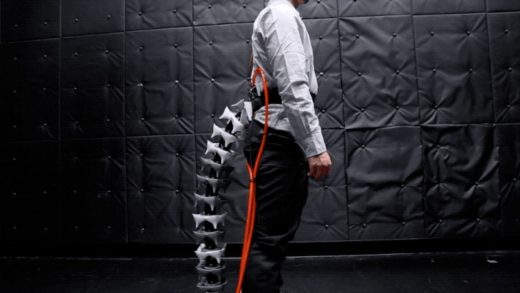Robotic tails for humans are here
Have you ever wondered what it would be like to have a tail, like a monkey or a wolf?
Wonder no longer. A group of researchers from Keio University in Japan has created a robotic tail for humans. Called Arque, the robotic tail prototype was designed to do what a real tail does: balance out the rest of the body. The researchers, who are part of Keio’s graduate school of media design, presented the work last week at the 2019 SIGGRAPH conference in Los Angeles, which focuses on graphics, gaming, and emerging technology.
The appendage was inspired by a seahorse’s tail, which is strong enough to withstand predators’ bites but still flexible to grip things in its environment, like coral. The researchers’ prototype was also designed to fit whoever ends up wearing it: the tail can be adjusted to the wearer’s body by adding or removing modular “vertebrae.” Small weights can be inserted inside each vertebrae to help offset the wearer’s weight, with the goal of helping the wearer stay balanced when moving quickly or carrying heavy objects. It could also be used in gaming to throw the user off-balance, making a game feel more realistic.
Once the tail is properly adjusted to the wearer’s height and weight, it acts like a counterbalance. Four artificial muscles run up and down the length of the tail and can contract and expand using an external pressurized air system that resembles a lawn mower or giant vacuum and can control the movement of the tail. Because the tail has to be anchored to this system, it’s not fully mobile, which means you wouldn’t be able to move very far using it. But if the researchers were to find a way to make it mobile, the tail could act as a support for laborers who have to carry heavy loads, or as an assistive device for people who have trouble balancing—though it remains to be seen if a robotic tail will ever be socially acceptable enough that someone would rather use it than a cane.
Fast Company , Read Full Story
(58)



